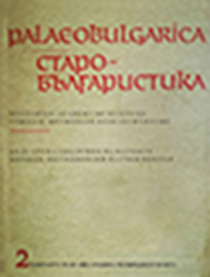Языковые особенности Парижского стихираря
Language Features of the Parisian Sticherarion
Author(s): Mariya A. PuzinaSubject(s): Language studies, Language and Literature Studies
Published by: Кирило-Методиевски научен център при Българска академия на науките
Keywords: history of the Bulgarian language; Slavic translated hymnography; Sticherarion; language features of the manuscript.
Summary/Abstract: The article deals with the spelling, phonetic, morphological and lexical features of the Parisian Sticherarion. The Parisian Sticherarion includes stichera from September 1 to September 14, written in the margins of a Greek manuscript of Plato's works (BNF, Paris.gr. 1808, pp. 25r – 34v). Phonetics and spelling indicate a significant antiquity of the monument. The morphological system is not so unambiguous. The Parisian Sticherarion demonstrates both archaic features and innovations, individual signs of the destruction of the case system are obvious. At the same time, the mixing of cases is not systematic. From a vocabulary point of view, two groups of words are of interest: a) lexemes noted in other manuscripts (Ilya's book, the most ancient Slavic monuments etc.) as possible translations of the corresponding Greek words and b) lexemes that are not found anywhere in connection with the corresponding Greek words. The second group is divided into several subgroups: reflection of probable discrepancies in the Greek manuscript, non-standard translation using known lexemes, new meanings of known lexemes, new lexicographically undescribed lexemes, paronymic replacements of a Greek word in translation, including decomposition of a composite with elements of paronymy, and transliteration of Greek words using Cyrillic. The linguistic usus and individual linguistic and textual innovations (greekism иерио, indication of authorship in the title of the sticheron) indicate the appearance of the text in the West Bulgarian area or (according to A. Bruni) in the monastery center outside Bulgaria by a native of the West Bulgaria not earlier than the end of the 12th century or more likely at the beginning of the 13th century.
Journal: PALAEOBULGARICA / СТАРОБЪЛГАРИСТИКА
- Issue Year: 2021
- Issue No: 2
- Page Range: 103-156
- Page Count: 54
- Language: Russian
- Content File-PDF

